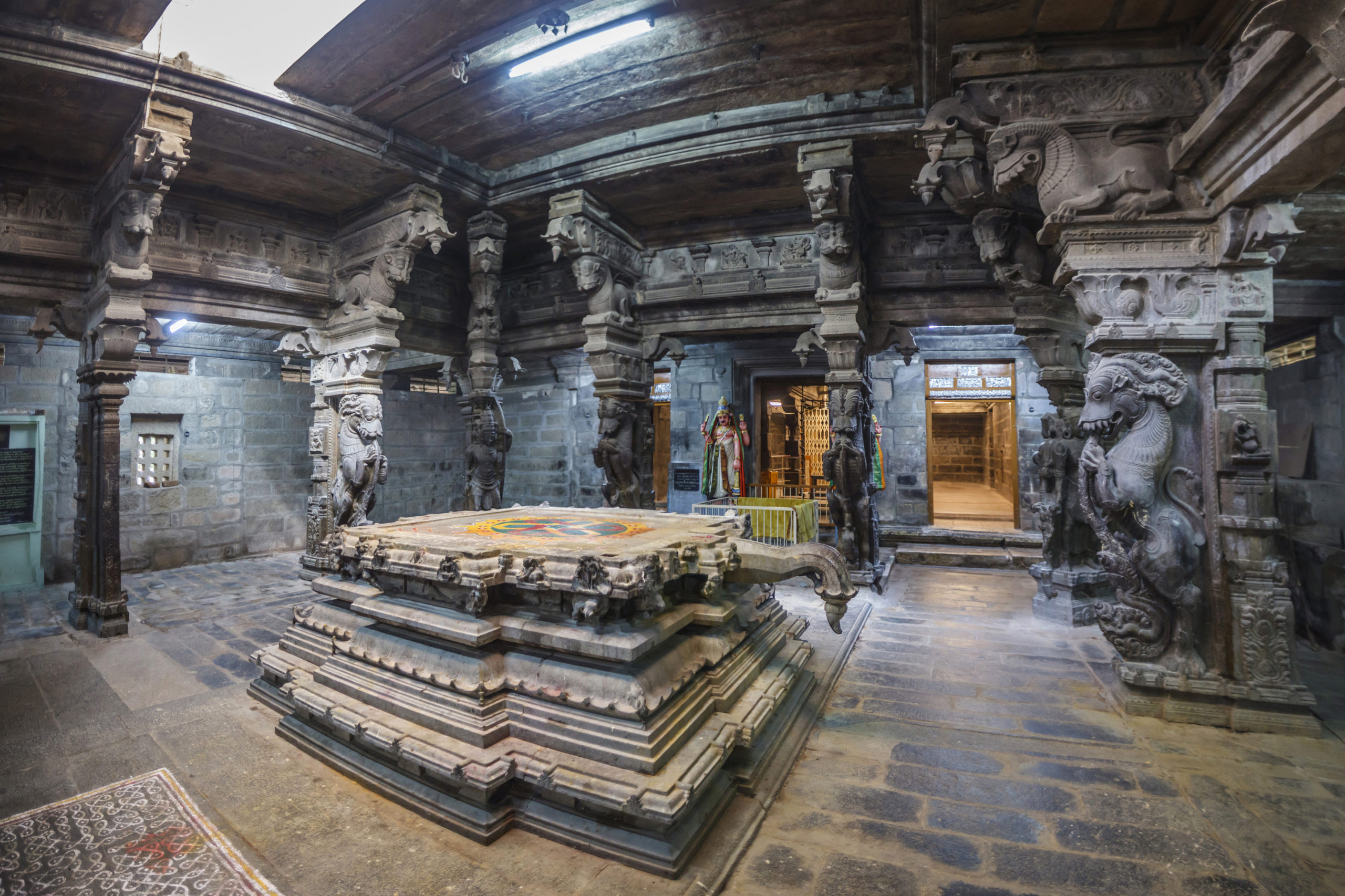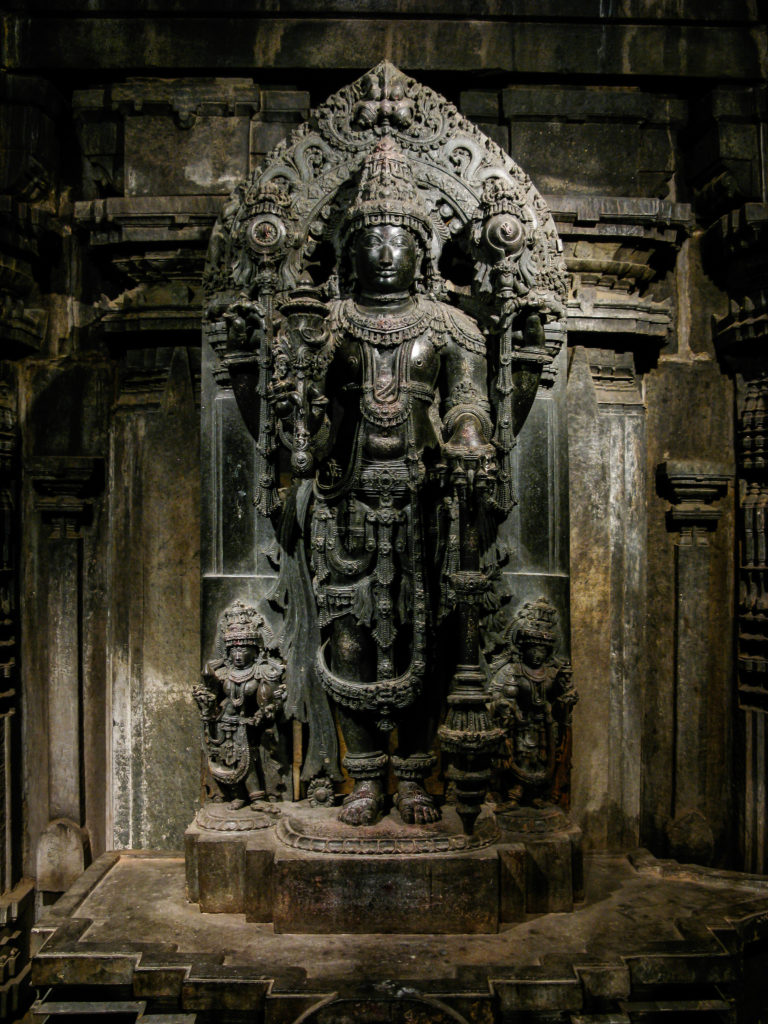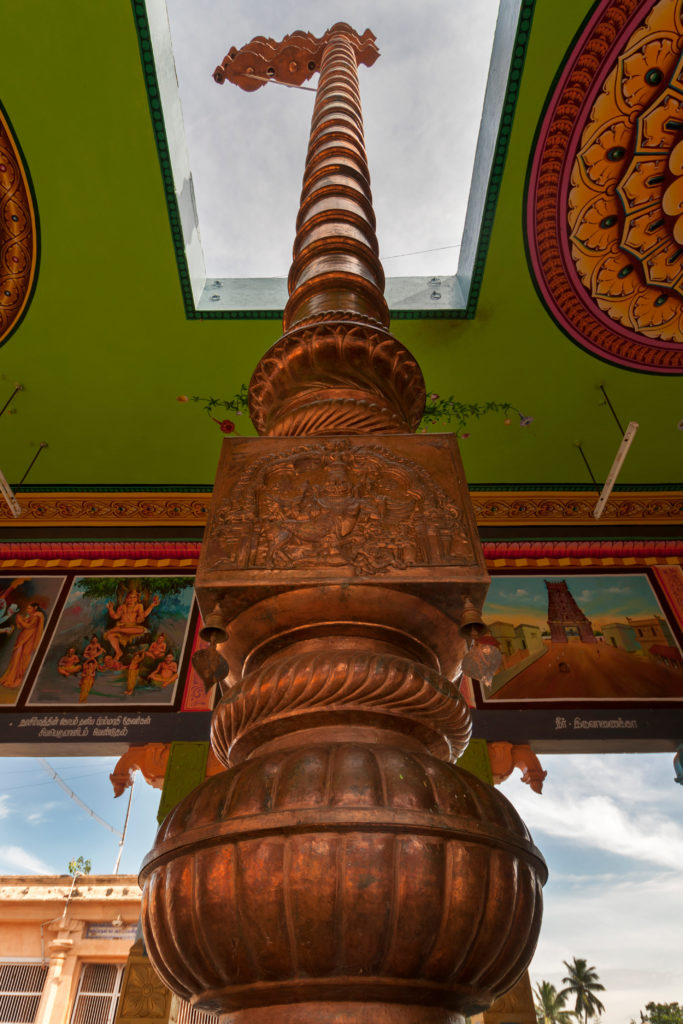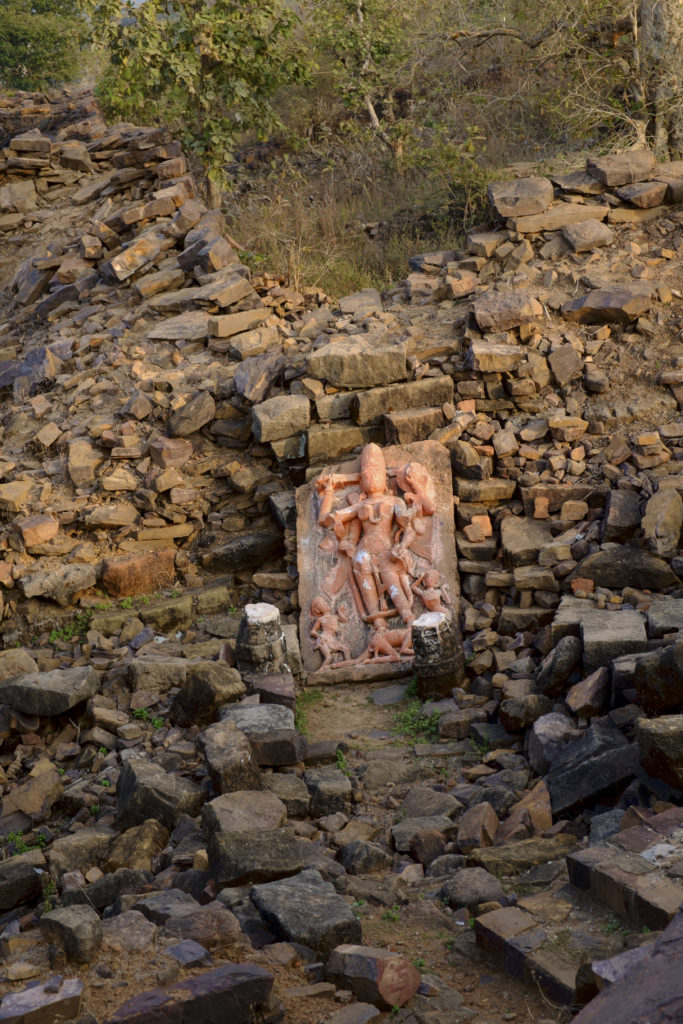The Mystical Importance of
Preserving Hindu Temples
The Saints and Sages, inspired by their love for humanity
and their desire to see suffering reduced in the world, have
identified some very powerful spiritual centers which can be
visited by people to harness the healing and uplifting effects,
and they have constructed Temples there to mark the
sacred sites and ensure that their healing powers be nourished
and preserved.

In India, there are many great Temples. A few are very famous and prospering due to the donations of many pilgrims who visit each year. Though Hinduism has no centralized organization like the Catholic faith, and each Temple is more or less entirely self-sufficient, the world’s wealthiest religious institutions are Hindu Temples. Famous Temples like Tirupati in Andhra Pradesh, Shirdi in Maharashtra, Shri Siddhivinayak in Mumbai, Soma Nath in Gujarat, Vaishno Devi in Jammu, Meenakshi in Tamil Nadu, Sabarimala in Kerala, Jagganath in Puri, and Vishvanath in Kashi receive millions of visitors a year and their worth in US dollars is in the billions.
Some of these Temples still hold massive amounts of gold and diamonds and precious gems and metals and artifacts from ancient times like Padmanabhaswamy Temple in Kerala which is said to be the world’s wealthiest Temple. Many such Temples have been looted by British and Mughal invaders and in more recent times by corrupt priests and temple managers including government officials who oversee temples seized by the Indian government. But a few temples still have great wealth and great popularity. Wealthy Temples have often decorated the inner sanctums with gold and silver and gems for their spiritual power. These substances help to open channels to the inner realms so that the Devas can affect things in the world. The placement of such valuable substances in Temples is not merely symbolic but has great mystical significance and is essential to their ability to bring spiritual energy into the world for the benefit of humanity. Many wealthy Temples have their Gopurams and Vimanams (temple towers) gilt in Gold to attract Devas and they have massive amounts of gold and other precious minerals within which creates a light that can be seen for a great distance from the inner realms. Many smaller and lesser-known Temples are however crumbling due to neglect and many are suffering from the desecration of selfish and worldly souls unaware of the spiritual power of these sacred sites.
Nearly every Hindu person in the world is aware of famous Saints like Shirdi Sai Baba, and there are few who do not have great reverence for Baba in particular. But there have been many thousands of Saints throughout Indian History who are not as well known. Their contributions to the world have been equally important. Many of these Saints have constructed sacred sites for the benefit of humanity. These Temples remain as their blessing to the world. The stories and the teachings of the Saints may inspire people, but it is the Temple that carries the shakti of the awakened masters as a blessing to the people. These blessings can heal a person; they can answer questions; they can empower people’s efforts, and they can stimulate spiritual initiation or awakening for sincere seekers. Through the mystical science of Temple construction, these blessings can be housed, preserved, and maintained over centuries so that a person need not read the Yoga Sutras of Patanjali to learn Yoga: they can go to Chidambaram Nataraj Temple which was consecrated by Patanjali himself and receive the direct blessing of the master to awaken their practice of Yoga. Any amount of reading on the subject would not give true knowledge which is attained in practice which must be initiated by an awakened master.

For the Temples with great fame, there is no trouble maintaining the ancient structures and conducting regular worship as prescribed by the shastra to preserve the spiritual energies of those Holy places. It is estimated that there are around 2 million Hindu Temples in the world today. Many of these temples were established by great Saints. Many are the Jeeva samadhis (resting places for the physical remains) of the Saints. Many of the Temples have great spiritual significance which is not well known or even forgotten entirely. These Temples each have unique effects upon pilgrims who visit them and they house unique and varied Vigrahas (consecrated images of the Lord). Some of these Vigrahas are wish-fulfilling; others reflect a person’s inner state to them; others answer questions; some hold the power to heal disease; others help to overcome obstacles; some aid in education; others help to resolve ancestral debts; some remove the effects of bad deeds; some help to bring about happy marriage; some help to bestow progeny, and a few even hold the power to remove the effects of doing bad deeds in other holy sites.

The Vigrahas (Temple Icons) are unique and varied. They are not mere stone. Through the rituals of consecration, pranapratishtha and kumbhabhishekam, they become channels for spiritual beings to access the physical realm and they become supercharged transmitters and amplifiers for spiritual energy. Through these sacred rituals, bimba (a stone statue) becomes a vigraha (a sacred image of God). The vigrahams and Temples that house them are treated with great reverence, as a manifestation of God in the world, because of the sacred nature of their existence and the role they play to grant access to spiritual beings to heal and bless the living. Many such images were created with rare characteristics to facilitate a particular type of healing work. Great prayogams and austerities were conducted by the Saints at many of these sites in order to build the spiritual shakti for the benefit of the world. The energy of a Saint is their blessing. It is not their acts or their words, but their energetic presence in the world that stabilizes human consciousness, allows for the prayers of common people bound by egoism to be heard and answered, and initiates the spiritual awakening of seekers. Their mere presence creates energy centers in the world where they have lived and especially where they have conducted intense spiritual practices. Many Temples have also been constructed at naturally occurring sites of great spiritual power. Vastu shastra has knowledge of the flow of energy in the world and provides guidance for building designs based upon this knowledge. The construction of Temples helps to preserve and increase and spread positive spiritual energy for the benefit of humanity.
Each Temple is unique. The image of Lord Murugan at Palani is known to have been made according to a secret Siddha procedure. The image is not carved of black granite like most others in the region but made instead of an alchemical amalgamation of navapashana, nine poisonous minerals, which when combined create a specially potent healing effect. This is like the alchemy of Ayurveda which turns poisonous liquid mercury into potent medicine capable of healing all diseases. Many Temple icons are made of solidified mercury also and these are also thought to have immense healing power. Some Temple vigrahas are swayambu, meaning naturally occurring, not carved by human hands, but made by God. In certain cases, Temples have been formed around sacred formations in mountains and other natural features of the land. Many Temples are the sites of important spiritual events, like Rameshwaram where Lord Rama stopped to worship before building a bridge of arrows to leave India and go to Shri Lanka or Ahobilam where Narasimha is said to have defeated the Demon, Hiranyakashipu. There are countless temples that have great significance attributed to them by the scriptures like the 12 Jyotirlingas, the Pancha Bhuta temples, the 64 Shakti Peethams, and countless others.
Many people are aware of a few famous Temples like Rameshwaram where Lord Ram is said to have established the Shivalingam which is worshiped today. There are many lesser-known Temples of equal importance. One priest I know works in a Ramalingeshwara Temple in Rajahmundry, Andhra Pradesh, which is also said to have been established by Lord Rama. There are many Temples great and small established not just by Lord Rama, but by the many thousands of other Saints and Rishis and Avataras. Each has been placed for a specific purpose by Divine Grace.
My Guru in Hyderabad had one master who used to take him to small, unknown Temples all over India and talk to him about the great importance of those sacred sites. He said that their spiritual power was held not in the building or the stone images but in energetic manifestations which he called “aksharas.” Akshara is the word for the Sanskrit sounds or letters. Akshara can also mean something which is “fixed” or also “sacrifice.” These energetic bodies get fixed in certain places where great sacrifices have been conducted. They imbue the physical matter around them with a certain energy, like a positive spiritual radiation. The beeja aksharas (seed syllables) inscribed on the pratishtha yantras installed along with the deity’s image and recited by the priests during rituals of consecration, help to establish these energetic manifestations. The aksharas may not be in proximity to the Temple building or the Vigraha worshiped there. In certain cases for various reasons, the aksharas will be located some distance from the inner sanctum of the Temple. I noticed once when I was keeping a few very powerful Vigrahams in an apartment complex where hundreds of other people lived, that though the physical statues were kept within the building, their energetic presence was outside the building in a forested area nearby. This undoubtedly occurred in order to help protect the people living in the building from the intensity of the spiritual energy which would not have been conducive to their health or happiness in such close proximity. There is a reason it is said that no person should live in a Temple. The Spiritual energy is power like medicine which can heal in the proper dose or hurt or kill in too large a quantity.
Such powerful spiritual energies occur on account of a combination of factors. But it is the procedures of worship and purification that help to sustain and maintain these spiritual presences which bestow the blessing of the Temples. The image itself is not so important, though spiritual energy tends to increase in them through centuries of worship. It is for this reason that certain long-lasting substances like stones that are conducive to holding spiritual energies like granite and marble and certain metals like gold and silver and copper and bell metal are prescribed for use in worship. The energy is not necessarily connected to the physical items themselves. The spiritual energy is in fact removed entirely from the sacred Temples regularly during rituals of purification and reconsecration. The ancient Temples have very powerful aksharas there which are capable of great things. These aksharas have magnificent power which can act as a conscious entity does. There is Divine consciousness in all things, but the aksharas are potent with the energy of Divine consciousness. Each of these Temples has a powerful effect on human consciousness and upon the course of history. Each has its part to play in helping to avert certain disasters and increasing the prosperity and wellbeing of humanity. Each was established by God through the work of pious people to serve a particular purpose. Guruji has talked about hundreds of such temples and their significance. He tells of visiting these temples and the mystical experiences he has had there.
Most people are not aware however of such powerful energetic presences around them, though there are many in every city on Earth. The Saints and Sages, inspired by their love for humanity and their desire to see suffering reduced in the world, have identified some very powerful spiritual centers which can be visited by people to harness the healing and uplifting effects, and they have constructed Temples there to mark the sacred sites and ensure that their healing powers be nourished and preserved. Many such sites exist throughout the world whether they have been marked by a sacred structure or not. Some hold great power to heal and bless; others have the power to cause harm. Just as the selfless acts of spiritual souls can establish very nourishing and beneficial aksharas, the selfish and wicked deeds of ignorant souls can be equally powerful to open channels to the lower astral realm through which dark forces can wreak great havoc. There are dark aksharas also which cause much suffering for all who come close. Places of intense tragedy, like battlefields, often contain hundreds of such aksharas which inhibit human prosperity a great deal. For this reason, the scriptures have prohibited the building of temples in such places. In these sorts of places, it is likely that demonic forces would work through the channels opened by prayer. Even when a temple becomes neglected or desecrated, this can create an opening for dark forces to work through the spiritual channels of the temple. This is why priests conduct various rituals of self-purification before entering the Temple or coming in contact with the sacred images within. Such images have great power to amplify the prayers and intentions of the people. They can amplify people’s negative thoughts as well if certain precautionary measures are not taken to approach them with a spiritual mindset.

Each time a person bows at the Temple flagpole, they leave a little bit of their selfishness, their negativity, and their attachment. They in turn receive blessings from the sacred site and each time drain the sanctity of the Temple a little. This is one reason, there is always a bali peetham in close proximity to the dwajastambha (flag pole). Daily offerings of cooked rice are made at the bali peetham. These offerings are made in order to help remove negative energies left by the Temple devotees. Rice is very absorbent and can hold a great deal of energy for a short time. These offerings are also made for the benefit of spiritual beings, ghosts, and demons which get satiated by the offerings and leave the Temple unharmed. These beings seek to gain access to the physical realm to fulfill their selfish desires. A Temple has a propensity to become a doorway to the physical realm for spiritual beings caught in darkness and intent upon harming humanity if its sanctity is allowed to be deplenished. This is why the shastras mandate that every Temple must be purified and reconsecrated every 12 years through kumbhabhishekam rituals. Daily offerings are made in Temples to remove negative energies and to sustain positive spiritual energy, but even with these regular offerings, the sanctity of the Temple is bound to become degraded over time.
The basic daily rituals include abhishekam (bathing rituals) for each deity and bali offerings. After 12 years generally, significant damage to the spiritual aksharas will begin to occur which necessitates special rituals to be conducted. If these rituals are not done, the aksharas which had been blessing the people, averting world tragedies, and stabilizing human consciousness can easily become negative forces through which spiritual beings can cause great harm to the world. If the daily rituals are discontinued in a Temple, the spiritual energies are depleted much more quickly. Certain inauspicious events occurring in the Temple also will tend to cause harm to the spiritual energies there and necessitate a re-consecration to occur sooner than the prescribed 12 years. If repairs or renovations are done to a Temple, this disturbs the flow of spiritual energy and it is considered necessary to re-consecrate the Temple immediately upon completion of such work. If a person or a large animal dies in the Temple, also this is thought to require a reconsecration. Certain extremely inauspicious events would even lead to the need to abandon a particular site, like the killing of many people in the Temple.
This is why, the shastras have recommended that if worship is discontinued for a sacred icon of God after pranapratishtha rituals have been done, that image should be placed into running water like a river or ocean. This helps wash away any potentially harmful effects and returns the energies to the Earth. This is the best prescription for a sacred image that has fallen into neglect for which it is not possible to do the property rituals to sustain its spiritual power. Adhivasam (placing the image in water) is also done in the case of damage to the physical icon. Damage is considered inauspicious. It is thought that worship of such an image could even cause harm. To avert this potential, the image is returned respectfully to the water.
Though the sacred icons can have a great deal of spiritual energy associated with them and they are afforded great reverence by the devout, it is understood that God is in all things. Stone is stone. It will one day crumble into dust. It does not last forever. Nothing in this world lasts forever. Only God is eternal. In the case that a vigraham is damaged, a replacement can be made. Then through special rituals, the spiritual energies can be taken out of the damaged image and then placed into the replacement. It is a mystical science, which requires continual effort. Though this process is considered “idol worship” by detractors, this cannot be claimed if there is knowledge of the process of consecration. The physical image has certain iconography which has an effect on consciousness when viewed. But the image itself is a point of focus for our meditation, not really a manifestation of God. God is in all things. When a person meditates, they begin to see God in everything. A channel is opened through this spiritual awareness which allows human consciousness to more easily go into a state of deep meditative awareness. This also opens channels to allow Devas access to the physical realm to bless the people. But these channels are spiritual and not physical.

During the reconsecration of any Temple, all the spiritual energies are removed entirely from the Temple. A temporary pavilion is constructed outside the Temple. The spiritual energies associated with each vigraha and the associated temple towers are all placed into kumbhas (water pots) kept outside the Temple in the pavilion. Then the Temple is purified completely of all negative energies. It is made to be pure, like a clean slate, through the rituals. Then rituals are done to build the spiritual energies before they are placed back into the shrines and Temple towers. Through such rituals, all negative energy is removed from the sacred Temple and the spiritual energies are built. The icons become more powerful and the Temple towers become able to project the blessings even further to the surrounding area. When we maintain Temples, they bring peace and prosperity to people in the surrounding area. Yet when Temples are neglected, dark forces rush in, to try to cause harm through the channels opened by the Saints.
The design of almost every Temple has been extremely deliberate. There are shastras that detail the elaborate specifications for Temple design. Each architectural feature has been placed with an energetic purpose. Each item offered also serves a mystical purpose.
I attended a recent consecration of a new Temple performed by my Guru in the US. In every Temple consecration, yantras carved in gold or silver or copper are installed in the peetham under the deity. Along with these, nine gems and seven metals are installed also to help empower the image. At this particular consecration, along with the nine gems associated with the nine Planets of Vedic astrology, numerous additional pearls were installed. This was done to help balance fire energies associated with the property’s vastu. The property had its entrance in the South East, the direction of fire. This was necessary due to the orientation of the access road. There are several vastu doshas in that direction on the property which in combination with the SE entrance had been increasing the fiery energy of the property. The Temple in fact experienced several fires. A fountain was also installed in the South East in order to help pacify these fiery energies. These things together have eased the imperfections of the property and stopped troubles through fire. Without such measures, surely the fiery energy of the property would have a propensity to be increased by the worship done there and destructive forces sent to the surrounding areas through the Temple towers. This is a great example of the mystical significance of the Temple structure and the specific valuable materials used during Temple consecration. If invaders were to seize this Temple and remove the images, they would find a wealth of pearls. They may ask the question “Why does God need such wealth.” They may decide that they could make better use of this wealth and sell these pearls, but then the pearls would no longer be able to ease the fiery energy of that powerful site. With powerful aksharas established, yet tempered by the intentional design and specific offerings, the sacred space could begin to cause great harm to those who desecrated the site and to society at large. There are great karmic repercussions for disturbing the sanctity of a Holy site like this. We can understand in this light the great importance of preserving our sacred Temples, their land, and their assets.
I have heard some people say that the Temples in India own too much land. They claim Temples that having this land does no good to society. They argue the land should be seized from Temples and given to poor people to farm or be used in some other way. Much Temple land has been lost in recent years. The land associated with the Temples is important for their proper functioning. Each Temple structure and every vigraham has been designed in relation to the shape and size of the specific Temple property. For the Temples to maintain their maximum effect to bless the people, it is essential that the historic property for which the Temple had been designed be maintained. Undeveloped land or agricultural land is much more conducive to supporting the manifestation and dispensation of spiritual energy than land inhabited or used by people. Many Temples are surrounded by a great deal of forested land, which acts as a nature reserve for positive spiritual forces which serve humanity. Even as the destruction of the rainforests leads to the extinction of many rare species of plant and animal which thrived in the unique habitat of the forest, the destruction of sacred Temple lands is closing channels to the inner realms and stopping the blessings to the world by displacing many spiritual beings and energies which thrive in the conducive atmosphere of the Temple land. Temple lands provide refuge for many rare and beneficial spiritual beings and forces that are a great aid to humanity. But most people do not see these spiritual things and so they think of material benefits only. We must remember that everything that is has come from the Lord and that the physical realm depends upon the support of many inner plane beings and forces. We can feel the great power of the sacred spiritual sites which have been well maintained. We can also feel if we pay careful attention to the negative energy of spiritual sites which have been neglected.
There are many spiritual sites I am aware of where the proper rituals are neglected, that I personally work to purify and re-energize. I will tell of one such site. It is a Buddhist Stupa not far from where I live in Virginia. This Stupa was built by a powerful Tibetan Lama on land owned by one devotee. That devotee was going to donate the land to the Lama, but after the Stupa had been constructed and consecrated, the plan changed and this devotee sold the land to a famous musician. After this only limited access was granted to devotees of the Lama and the Stupa fell into disuse. Since that time the land changed hands again. Today, that Lama has passed from his mortal body, but his devotees are still granted limited access to the Stupa. When I first visited it, frankly it felt terrible. It was dusty and dirty. Cobwebs blocked the doorway and poisonous black widow spiders were everywhere. It felt haunted and seemed to be projecting vile energy all around it like toxic radiation. I went with one disciple of that Lama. We cleaned the Stupa and carefully removed the spiders and then we chanted a few Vedic hymns and Tibetan mantras. Quickly and nearly effortlessly it seemed the energy shifted. What felt like a channel to the dark realms, quickly began to feel like that Lama again and the Stupa again began conferring the blessings of the Buddha and the Bodhisattvas to the surrounding area. Since that time, I have encouraged the Devotees of that Lama to go and clean the Stupa and to practice there as often as possible. I check in on it occasionally myself also. It is not difficult to maintain, because Stupas like this were designed to send out blessings without the need for elaborate daily rituals, but it does still require some effort, or the positive spiritual energy quickly degrades into a potent curse to all who come near.
The presence of Temples in this world is a great blessing and a great responsibility. We should not keep them around because they are beautiful to look at. We must have some understanding of their spiritual effect on the world, and we must maintain them energetically, including cleaning them regularly and repairing damage to the structures and sacred images within. This work brings us into direct communion with the blessings of the Saints and the many thousands of Devas working through the sacred Temples. Participating in such work is not really possible at the big and famous Temples like Tirupati. People vie for these opportunities and only the rare few are lucky enough to be blessed with such opportunities. Even a large donation is insignificant for such wealthy Temples. But there are many equally powerful and equally important sacred sites that are suffering from neglect and are in great need of our help. We must do what we can to clean them and restore them to their previous glory before it becomes too late to save them. There is a certain point of no return after which it is no longer possible to reestablish what has been lost. Then our connection to the Sages and Saints and the unique aksharas of these Temples will be lost forever. We should all do what we can to educate people about this pressing concern and donate as we are able. The Agamas tell of unspeakable punyam (merit) which is incurred by supporting the efforts to preserve the sacred sites and participating in the sacred rituals of kumbhabhishekam which maintain our connection to the ancient sages. Sanatana Dharma is the world’s oldest living religion because we still have an energetic connection to our ancient Sages. We must fight to preserve this connection by working diligently to preserve the sacred sites before it is too late.

– Gananathamritananda Giri
Peethadhipati of the Soma Matha Spiritual Center in Schuyler, Virginia
www.somamatha.org
